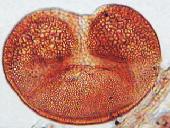|
 See More Images See More Images

Picea
© 2003 John H. Wrenn, Louisiana State University
|
What are Spores and Pollen? Both spores and pollen are reproductive products that are generally single cells. The fungi, mosses, liverworts, hornworts, and seedless vascular plants produce spores, but only seed-bearing plants produce pollen. Often microscopic in size, durable, and easily transported, pollen and spores can be found in many different environments and have a long fossil record (at least as far back as the Devonian), making them very useful for biostratigraphy. However, because many different plants and fungi produce similar-looking spores or pollen, it is sometimes difficult to identify them in the fossil record. First known fossil occurrence: Devonian. Last known fossil occurrence: Quaternary. This group has living relatives. |
Fossils through time:
Choose a time period to see what life was like:
|
|